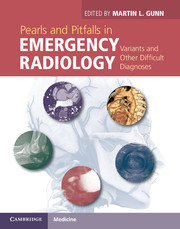Book contents
- Frontmatter
- Contents
- List of contributors
- Preface
- Acknowledgments
- Section 1 Brain, head, and neck
- Section 2 Spine
- Section 3 Thorax
- Case 30 Pseudopneumomediastinum
- Case 31 Traumatic pneumomediastinum without aerodigestive injury
- Case 32 Pseudopneumothorax
- Case 33 Subcutaneous emphysema and mimickers
- Case 34 Tracheal injury
- Case 35 Pulmonary contusion and laceration
- Case 36 Sternoclavicular dislocation
- Case 37 Boerhaave syndrome
- Case 38 Variants and hernias of the diaphragm simulating injury
- Section 4 Cardiovascular
- Section 5 Abdomen
- Section 6 Pelvis
- Section 7 Musculoskeletal
- Section 8 Pediatrics
- Index
- References
Case 38 - Variants and hernias of the diaphragm simulating injury
from Section 3 - Thorax
Published online by Cambridge University Press: 05 March 2013
- Frontmatter
- Contents
- List of contributors
- Preface
- Acknowledgments
- Section 1 Brain, head, and neck
- Section 2 Spine
- Section 3 Thorax
- Case 30 Pseudopneumomediastinum
- Case 31 Traumatic pneumomediastinum without aerodigestive injury
- Case 32 Pseudopneumothorax
- Case 33 Subcutaneous emphysema and mimickers
- Case 34 Tracheal injury
- Case 35 Pulmonary contusion and laceration
- Case 36 Sternoclavicular dislocation
- Case 37 Boerhaave syndrome
- Case 38 Variants and hernias of the diaphragm simulating injury
- Section 4 Cardiovascular
- Section 5 Abdomen
- Section 6 Pelvis
- Section 7 Musculoskeletal
- Section 8 Pediatrics
- Index
- References
Summary
Imaging description
Most blunt diaphragmatic ruptures are longer than 10 cm and occur along the posterolateral aspect of the left hemidiaphragm [1]. Imaging findings of diaphragmatic rupture on chest radiography include an intrathoracic location of abdominal viscera (with or without the “collar sign”) a nasogastric tube above the left hemidiaphragm, distortion or obliteration of hemidiaphragm outline, contralateral mediastinal shift, and marked elevation of the left hemidiaphragm (> 4 cm) compared to the right [1–3]. CT findings of diaphragmatic injuries include segmental diaphragm non-visualization, intrathoracic herniation of viscera, collar sign, dependent viscera sign, and a thickened diaphragm (Figure 38.1) [3]. Although sensitive for injury, focal thickening of the diaphragm in the absence of other signs of diaphragmatic injury is not specific [4].
Diagnostic pitfalls for diaphragmatic injury include hernias (Bochdalek, Morgagni, and hiatal) and discontinuity of the diaphragm between crura and lateral arcuate ligaments [5].
Foramen of Bochdalek hernias
The foramen of Bochdalek is a 2cm opening in the posterior fetal diaphragm that normally closes by the eighth week of gestation. The left foramen closes later than the right. Hence, 85% of Bochdalek hernias occur on the left [6]. Most symptomatic Bochdalek hernias present in the neonatal period whereas asymptomatic foramina and hernias are detected incidentally later in life, during imaging for other reasons.
Information
- Type
- Chapter
- Information
- Pearls and Pitfalls in Emergency RadiologyVariants and Other Difficult Diagnoses, pp. 128 - 130Publisher: Cambridge University PressPrint publication year: 2013
